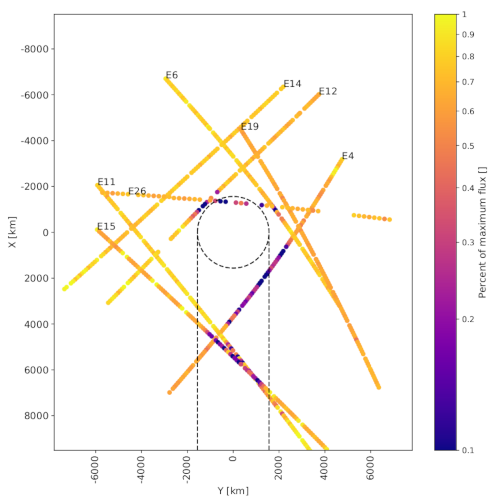Abstract
Results for 2D molecular kinetics models of single- and multi-component Callisto-like atmospheres are presented. The evolution of these neutral atmospheres is driven by the diurnal changes in surface temperatures, intermolecular collisions, and thermal escape.
Galileo and Hubble Space Telescope (HST) observations of Callisto, the outermost Galilean moon of Jupiter, have shown it possesses an atmosphere. However, the origin, composition, and evolution of this atmosphere are still not well understood. It ranges from a surface-bound exosphere to a collisional atmosphere with an exobase located above the surface. These spatial and temporal variations are driven by the diurnal changes in surface temperatures as well as by incident plasma and UV photons.
Galileo first observed a tenuous CO2 atmosphere on Callisto via airglow emissions [1]. Several processes, such as radiolysis, were suggested to be the source of the atmosphere, and its extent was suggested to be global, driven by the diurnal variations of surface temperatures and the volatility and mobility of CO2. Galileo radio occultations indicated the presence of a substantial ionosphere via measured electron density profiles near the terminator region [2]. Analogous to the O2 atmosphere on Europa, a much thicker O2-dominated atmosphere was suggested to exist at Callisto. UV auroral emissions were not detected in subsequent HST-Space Telescope Imaging Spectrograph (STIS) observations, but upper limits of C and O were estimated [3].
Based on these observations, a range of chemical and photochemical models were applied to Callisto-like atmospheres [4]. Photoionizaton of the observed CO2 was shown to be insufficient to generate the observed electron density profiles and, thus, a more dense, predominantly O2 atmosphere was suggested to exist at Callisto. In addition, chemical reactions in a porous regolith were shown to recycle the H2O, whose photochemical products suppressed the accumulation of O2, thereby preventing the O column density from exceeding the estimated upper limit.
Using the HST-Cosmic Origins Spectrograph (COS), O emissions from Callisto's atmosphere were detected, likely generated by photo-electrons in an O2-dominated atmosphere [5]. The density of this inferred O2 atmosphere was about an order of magnitude lower than was previously inferred. This difference in densities is likely due to Callisto's orbit relative to Jupiter and the Sun: the HST-COS observations occurred when Callisto's sunlit hemisphere was opposite its ram-side hemisphere, whereas the radio occultations occurred when the two hemispheres aligned. The HST-STIS observations were recently revisited and faint emissions from an atomic hydrogen corona, likely a photochemical product of H2O vapor, were detected [6]. Contrary to the aforementioned O2 asymmetries, the derived H corona was larger on the sunlit leading hemisphere than on the sunlit trailing hemisphere. This was suggested to be a result of the leading hemisphere's lower albedo and, thus, higher surface temperatures, which would enhance the H2O sublimation rate.
A Monte-Carlo model was used to simulate surface-bound Callisto-like ballistic exospheres, which varied in surface temperature and composition as well as atmospheric sources and sinks [7]. A subsequent study improved this model by differentiating between the cold and hot parts of the Jovian magnetosphere and considering the influence of ionospheric shielding [8].
Our recent study demonstrated the influence of collisions and thermal escape in single- and multi-component 1D Callisto-like neutral atmospheres [9]. Therein we assumed that the constituents of the atmospheres (O2, CO2, H2) were radiolytic products which thermally desorb from the surface according to the local temperature and on returning to the surface they permeate the porous regolith and become trapped in the radiation-damaged ice. Using the direct simulation Monte Carlo (DSMC) method [10] we calculated translational and internal energy exchanges via intermolecular collisions between test particles. Our results demonstrated that collisions can suppress or enhance H2 thermal escape relative to Jeans (ballistic) escape and collisions between the escaping H2 and O2 and CO2 affected the heavier species' structure, producing non-isothermal profiles. We also compared these results to ballistic models and demonstrated where the latter breaks down.
Model
Here we expand our previous models to 2D to include the diurnal variation of surface temperatures as well as include H2O sublimation, which is extremely sensitive to Callisto's surface temperatures, varying ~15 orders of magnitude from noon (T0 = 155 K) to midnight (T0 = 80 K). The additional dimension in these models varies along Callisto's subsolar latitude (SSL), where the surface temperature varies from noon (SSL = 0) to midnight (SSL = 180). We track test particles from their original SSL to the SSL they return to the surface at or, in the case of H2, they escape from. Thus, local as well as global fluxes and subsequent return and escape rates can be calculated as a means to better understand the distribution of Callisto's neutral atmosphere. Moreover, thermal winds induced by collisions of particles from the warmer regions of the atmosphere with particles from the colder regions are observed, thereby influencing the local distribution.
References
[1] Carlson, R.: A tenuous carbon dioxide atmosphere on Jupiter's moon Callisto, Science, 1999.
[2] Kliore, A., et al.: Ionosphere of Callisto from Galileo radio occultation observations, Journal of Geophysical Research: Space Physics, 2002.
[3] Strobel, D., et al.: Hubble Space Telescope space telescope imaging spectrograph search for an atmosphere on Callisto: A Jovian unipolar inductor, The Astrophysical Journal Letters, 2002.
[4] Liang, M.-C., et al.: Atmosphere of Callisto, Journal of Geophysical Research: Planets, 2005.
[5] Cunningham, N., et al.: Detection of Callisto's oxygen atmosphere with the Hubble Space Telescope, Icarus, 2015.
[6] Roth, L., et al.: Detection of a hydrogen corona at Callisto, Journal of Geophysical Research: Planets, 2017.
[7] Vorburger, A., et al.: Monte-Carlo simulation of Callisto's exosphere, Icarus, 2017.
[8] Vorburger, A., et al.: 3D-modeling of Callisto's surface sputtered exosphere environment, Journal of Geophysical Research: Space Physics, 2019.
[9] Carberry Mogan, S., et al.: The influence of collisions and thermal escape in Callisto's atmosphere, Icarus, 2020.
[10] Bird, G.: Molecular gas dynamics and the direct simulation of gas flows, Clarendon Press, 1994.








